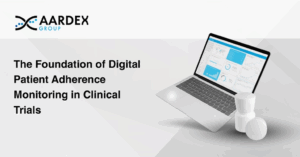While digital pills have long been hailed as a valuable solution to the stubborn medication adherence problem, there have been questions about their use, in terms of intrusiveness, acceptance, and reliability. But with the evidence base expanding, there are opportunities to embrace the paradigm-shifting potential of this innovative solution.
A stubborn challenge
It’s no secret that poor adherence to medication is a problem in clinical trials and routine practice alike.
Studies have shown that up to 30% of study participants1 have sub-optimal medication behavior. The consequences are obvious: even the most efficacious therapies will not work if people do not take them. Poor adherence can lead to underestimations of investigational product efficacy, draining study power, potentially to the point of study failure.
All this has been well-documented over decades of research, yet the problem has remained a stubborn one, due in part to a lack of workable management strategies.
Self- or healthcare professional (HCP) report, for example, is subjective and vulnerable to intentional and accidental bias. Measuring drug metabolites, whether in hair, urine, or blood, is intrusive and burdensome for patients.
Importantly, such traditional methods provide a snapshot of medicine-taking behavior, not the 360°, holistic view researchers need to monitor and, crucially, manage poor adherence before it can impact drug efficacy.
In the last few years, medication adherence packaging, which includes digital delivery systems (e.g. injectable) and digital pills, have emerged as a possible solution.
One example is the Food and Drug Administration (FDA)-approved ID-Cap™ System, from AARDEX Group’s partner, etectRx. The ID-Cap system includes digital sensors inside the drug capsule. When activated by stomach acid, the sensor sends a signal to a reader, which in turn transmits the information to a dedicated mobile app.
Combined with ARRDEX Group’s Medication Adherence Software, the approach enables investigators to spot erratic dosing patterns, such as missed capsules or medication holidays, risk stratify patients, and deliver targeted, corrective support.
Expanding evidence base
The digital pill approach is evidence based. A 2022 narrative review of ingestible electronic sensors found 21 papers, including 18 clinical trials that deployed an ingestible sensor in human populations, and three investigations involving exploratory qualitative work.2
The mean accuracy of the sensor to successfully detect a medication ingestion event ranged from 68% to 100% in pilot studies. In real-world clinical settings, accuracy ranged from 68% to 90%, with the lower accuracy rates being attributed to non-adherence to the digital pill system technology. That compares to 60% accuracy for pill count, 50% for healthcare professional rating, and just 27% for self-report.3
Patients have also expressed their satisfaction with digital pill systems, as demonstrated by one study among men taking ID-Cap enabled pre-exposure prophylaxis (PrEP) to prevent HIV.
When taken as directed, PrEP, which is indicated for people with HIV risk factors such as condomless sex, recent sexually transmitted infection, or injection drug use4, is 99% effective in preventing infection.5 However, as with most medical treatments, efficacy is closely linked to adherence,5 and this can be poor.
After 90 days of using the system, the majority of the study participants said it was valuable, with many saying that having access to their data “increased their perceived accountability for adhering” to the medication. They also found it useful to have an on-demand record of their PrEp use, with one participant saying: “When I take it without the machine, sometimes I wonder whether or not I’ve taken it, so it’s good to… keep track for my records when I’ve taken it and at what time.”5
The time is now
No one can afford to ignore the problem of poor adherence, which drives up clinical trial and healthcare costs, at the same time as driving down patient outcomes.
Luckily, the solutions are now in our grasp. Digital pills can prove ingestion, which is particularly useful during early phase drug development, and are firmly in the running as an innovative solution to an age-old problem.
References
- El Alili, M., Vrijens, B., Demonceau, J., Evers, S. M., & Hiligsmann, M. (2016). A scoping review of studies comparing the medication event monitoring system (MEMS) with alternative methods for measuring medication adherence. British journal of clinical pharmacology, 82(1), 268-279.
- Chai, P. R., Vaz, C., Goodman, G. R., Albrechta, H., Huang, H., Rosen, R. K., … & O’Cleirigh, C. (2022). Ingestible electronic sensors to measure instantaneous medication adherence: A narrative review. Digital Health, 8, 20552076221083119.
- El Alili, M., Vrijens, B., Demonceau, J., Evers, S. M., & Hiligsmann, M. (2016). A scoping review of studies comparing the medication event monitoring system (MEMS) with alternative methods for measuring medication adherence. British journal of clinical pharmacology, 82(1), 268-279.
- Newborn, A. R. V. (2021). Recommendations for the Use of Antiretroviral Drugs During Pregnancy and Interventions to Reduce Perinatal HIV Transmission in the United States The information in the brief version is excerpted directly from the full-text guidelines. The brief version is a compilation of the tables and boxed recommendations. Management, 12, 00
- Chai, P. R., Goodman, G. R., Bronzi, O., Gonzales, G., Baez, A., Bustamante, M. J., … & Rosen, R. K. (2022). Real-World User Experiences with a Digital Pill System to Measure PrEP Adherence: Perspectives from MSM with Substance Use. AIDS and Behavior, 26(7), 2459-2468.



